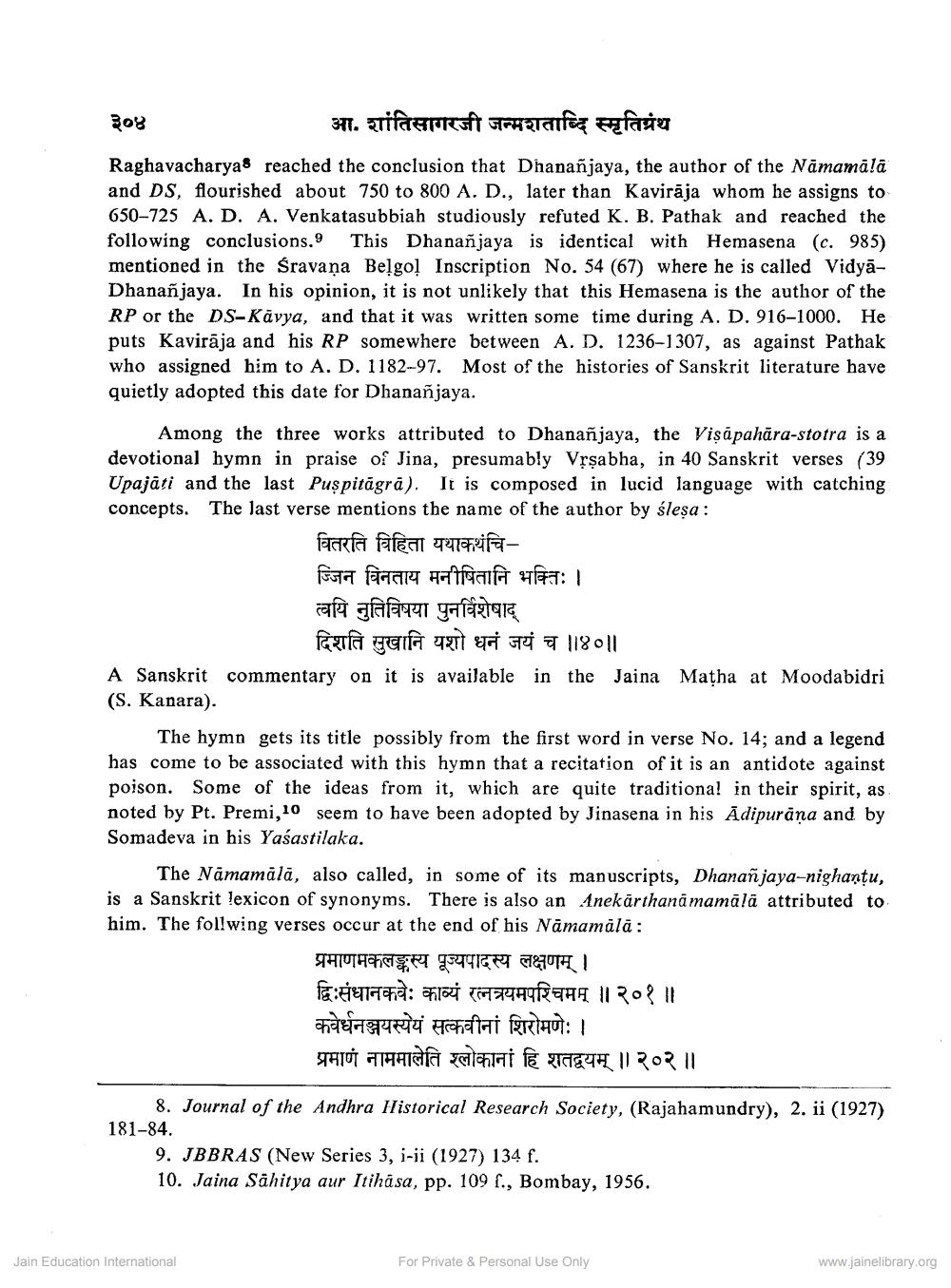Book Title: Dhananjaya and his Dwi Sadhana Author(s): A N Upadhye Publisher: Z_Acharya_Shantisagar_Janma_Shatabdi_Mahotsav_Smruti_Granth_012022.pdf View full book textPage 2
________________ ३०४ आ. शांतिसागरजी जन्मशताब्दि स्मृतिग्रंथ Raghavacharya8 reached the conclusion that Dhananjaya, the author of the Namamalā and DS, flourished about 750 to 800 A. D., later than Kaviraja whom he assigns to 650–725 A. D. A. Venkatasubbiah studiously refuted K. B. Pathak and reached the following conclusions. This Dhananjaya is identical with Hemasena (c. 985) mentioned in the Sravaņa Belgo! Inscription No. 54 (67) where he is called VidyāDhananjaya. In his opinion, it is not unlikely that this Hemasena is the author of the RP or the DS-Kavya, and that it was written some time during A. D. 916–1000. He puts Kaviraja and his RP somewhere between A. D. 1236-1307, as against Pathak who assigned him to A. D. 1182-97. Most of the histories of Sanskrit literature have quietly adopted this date for Dhananjaya. Among the three works attributed to Dhananjaya, the Visapahāra-stotra is a devotional hymn in praise of Jina, presumably Vrsabha, in 40 Sanskrit verses (39 Upajati and the last Puspitāgrā). It is composed in lucid language with catching concepts. The last verse mentions the name of the author by ślesa : वितरति विहिता यथाकथंचिज्जिन विनताय मनीषितानि भक्तिः । त्वयि नुतिविषया पुनर्विशेषाद् दिशति सुखानि यशो धनं जयं च ॥४०॥ A Sanskrit commentary on it is available in the Jaina Matha at Moodabidri (S. Kanara). The hymn gets its title possibly from the first word in verse No. 14; and a legend has come to be associated with this hymn that a recitation of it is an antidote against poison. Some of the ideas from it, which are quite traditional in their spirit, as noted by Pt. Premi,10 seem to have been adopted by Jinasena in his Ādipurāna and by Somadeva in his Yaśastilaka. The Namamālā, also called, in some of its manuscripts, Dhananjaya-nighantu, is a Sanskrit lexicon of synonyms. There is also an Anekārthanamamālā attributed to him. The follwing verses occur at the end of his Nāmamālā: प्रमाणमकलङ्कस्य पूज्यपादस्य लक्षणम् । द्विःसंधानकवेः काव्यं रत्नत्रयमपश्चिमम् ॥२०१॥ कवेर्धनञ्जयस्येयं सत्कवीनां शिरोमणेः । प्रमाणं नाममालेति श्लोकानां हि शतद्वयम् ॥२०२॥ 8. Journal of the Andhra Historical Research Society, (Rajahamundry), 2. ii (1927) 181-84. 9. JBBRAS (New Series 3, i-ii (1927) 134 f. 10. Jaina Sahitya aur Itihasa, pp. 109 s., Bombay, 1956. Jain Education International For Private & Personal Use Only www.jainelibrary.orgPage Navigation
1 2 3 4 5 6 7 8
